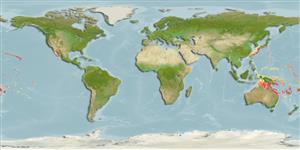Klassifizierung / Names
Namen | Synonyme | Catalog of Fishes(Gattung, Arten) | ITIS | CoL | WoRMS | Cloffa
Environment: milieu / climate zone / depth range / distribution range
Ökologie
seewasser demersal; tiefenbereich 12 - 122 m (Ref. 58302), usually 15 - 16 m (Ref. 11666). Subtropical
Pacific Ocean: Japan, New Caledonia, and Hawaii. Recently reported from Tonga (Ref. 53797).
Size / Gewicht / Alter
Maturity: Lm ? range ? - ? cm
Max length : 3.7 cm SL Männchen/unbestimmt; (Ref. 11666); 4.0 cm SL (female)
Rückenflossenstacheln (insgesamt): 4; Rückenflossenweichstrahlen (insgesamt): 9; Afterflossenstacheln 0; Afterflossenweichstrahlen: 8. Dorsoposterior edge of eye with a pair of supraorbital cirri. Long, somewhat pointed snout. Male with first dorsal fin high and elongate; and with an inverse Y-shaped, blackish brown blotch on the throat. The female with a large dark mark at the base of its pelvic fin (Ref. 37433).
Found on mixed volcanic and coral sand, broken shells, and rubble substrate, with low relief and no algal cover (rarely on pure sand) (Ref. 11666). Benthic (Ref. 58302).
Life cycle and mating behavior
Geschlechtsreife | Fortpflanzung | Ablaichen | Eier | Fecundity | Larven
Fricke, R. and M.Z. Brownell, 1993. Two new dragonets of the genus Callionymus (Callionymidae) and a record of Callionymus corallinus from Miyake-jima, Izu Islands, Japan. Jap. J. Ichthyol. 40(1):1-10. (Ref. 11666)
IUCN Rote Liste Status (Ref. 130435)
Bedrohung für Menschen
Harmless
Nutzung durch Menschen
Mehr Information
NamenSynonymeMetabolismusRäuberÖkotoxikologieFortpflanzungGeschlechtsreifeAblaichenSpawning aggregationFecundityEierEientwicklung
ReferenzenAquakulturAquakultur ProfilZuchtlinienGenetikElectrophoresesVererbbarkeitKrankheitenVerarbeitungNutrientsMass conversion
PartnerBilderStamps, Coins Misc.LauteCiguateraGeschwindigkeitSchwimmstilKiemenoberflächeOtolithsGehirngrößeSehfähigkeit
Tools
Zusatzinformationen
Download XML
Internet Quellen
Estimates based on models
Preferred temperature (Ref.
123201): 23.7 - 27.8, mean 25.8 °C (based on 490 cells).
Phylogenetic diversity index (Ref.
82804): PD
50 = 0.5000 [Uniqueness, from 0.5 = low to 2.0 = high].
Bayesian length-weight: a=0.01148 (0.00455 - 0.02896), b=2.92 (2.70 - 3.14), in cm total length, based on LWR estimates for this (Sub)family-body shape (Ref.
93245).
Trophic level (Ref.
69278): 3.2 ±0.4 se; based on size and trophs of closest relatives
Widerstandsfähigkeit (Ref.
120179): hoch, Verdopplung der Population dauert weniger als 15 Monate. (Preliminary K or Fecundity.).
Fishing Vulnerability (Ref.
59153): Low vulnerability (10 of 100).
